Efficient Combination of Carbon Quantum Dots and BiVO4 for Significantly Enhanced Photocatalytic Activities
Abstract
:1. Introduction
2. Results and Discussion
2.1. Characterization of the Prepared Catalysts
2.2. Optical Properties and Band Structure Estimation
2.3. Photocatalytic Degradation of BzP over the as-Systhesized Catalysts
2.4. Insights into the Enhanced Photocatalytic Properties by CQD Modification
3. Materials and Methods
3.1. Chemicals
3.2. Synthesis of CQDs, BiVO4, and CQDs/BiVO4
3.3. Characterization
3.4. Photocatalytic Degradation of BzP
3.5. Photoelectrochemical Measurement
3.6. Photocatalytic Hydrogen Evolution Measurements
4. Conclusions
Supplementary Materials
Author Contributions
Funding
Data Availability Statement
Conflicts of Interest
References
- Zhu, M.; Sun, Z.; Fujitsuka, M.; Majima, T. Z-scheme photocatalytic water splitting on a 2D heterostructure of black phosphorus/bismuth vanadate using visible light. Angew. Chem. Int. Ed. 2018, 57, 2160–2164. [Google Scholar] [CrossRef]
- Jo, W.J.; Jang, J.-W.; Kong, K.-J.; Kang, H.J.; Kim, J.Y.; Jun, H.; Parmar, K.P.S.; Lee, J.S. Phosphate doping into monoclinic BiVO4 for enhanced photoelectrochemical water oxidation activity. Angew. Chem. Int. Ed. 2012, 51, 3147–3151. [Google Scholar] [CrossRef]
- Parmar, K.P.S.; Kang, H.J.; Bist, A.; Dua, P.; Jang, J.S.; Lee, J.S. Photocatalytic and photoelectrochemical water oxidation over metal-doped monoclinic BiVO4 photoanodes. ChemSusChem 2012, 5, 1926–1934. [Google Scholar] [CrossRef]
- Seabold, J.A.; Choi, K.-S. Efficient and stable photo-oxidation of water by a bismuth vanadate photoanode coupled with an iron oxyhydroxide oxygen evolution catalyst. J. Am. Chem. Soc. 2012, 134, 2186–2192. [Google Scholar] [CrossRef]
- Yuan, D.; Sun, M.; Tang, S.; Zhang, Y.; Wang, Z.; Qi, J.; Rao, Y.; Zhang, Q. All-solid-state BiVO4/ZnIn2S4 Z-scheme composite with efficient charge separations for improved visible light photocatalytic organics degradation. Chin. Chem. Lett. 2020, 31, 547–550. [Google Scholar] [CrossRef]
- Xu, X.; Ray, R.; Gu, Y.; Ploehn, H.J.; Gearheart, L.; Raker, K.; Scrivens, W.A. Electrophoretic analysis and purification of fluorescent single-walled carbon nanotube fragments. J. Am. Chem. Soc. 2004, 126, 12736–12737. [Google Scholar] [CrossRef]
- Wareing, T.C.; Gentile, P.; Phan, A.N. Biomass-based carbon dots: Current development and future perspectives. ACS Nano 2021, 15, 15471–15501. [Google Scholar] [CrossRef]
- Han, Y.D.; Wu, J.; Li, Y.; Gu, X.Q.; He, T.W.; Zhao, Y.; Huang, H.; Liu, Y.; Kang, Z.H. Carbon dots enhance the interface electron transfer and photoelectrochemical kinetics in TiO2 photoanode. Appl. Catal. B Environ. 2022, 304, 120983. [Google Scholar] [CrossRef]
- Wang, Z.; Cheng, Q.; Wang, X.; Li, J.; Li, W.; Li, Y.; Zhang, G. Carbon dots modified bismuth antimonate for broad spectrum photocatalytic degradation of organic pollutants: Boosted charge separation, DFT calculations and mechanism unveiling. Chem. Eng. J. 2021, 418, 129460. [Google Scholar] [CrossRef]
- Li, H.; Qing, Q.; Zheng, L.; Xie, L.; Gan, Z.; Huang, L.; Liu, S.; Wang, Z.; Lu, Y.; Chen, J. Carbon dots and carbon nitride composite for photocatalytic removal of uranium under air atmosphere. Chin. Chem. Lett. 2022, 33, 3573–3576. [Google Scholar] [CrossRef]
- Di, J.; Xia, J.; Ji, M.; Wang, B.; Yin, S.; Zhang, Q.; Chen, Z.; Li, H. Carbon quantum dots modified BiOCl ultrathin nanosheets with enhanced molecular oxygen activation ability for broad spectrum photocatalytic properties and mechanism insight. ACS Appl. Mater. Interfaces 2015, 7, 20111–20123. [Google Scholar] [CrossRef]
- Zhang, Z.; Huang, H.; Xu, J.; Zhang, N.; Zhang, C. Carbon quantum dots/BiVO4 composite with enhanced photocatalytic activity. Sci. China Technol. Sci. 2019, 62, 356–360. [Google Scholar] [CrossRef]
- Lin, X.; Liu, C.; Wang, J.; Yang, S.; Shi, J.; Hong, Y. Graphitic carbon nitride quantum dots and nitrogen-doped carbon quantum dots co-decorated with BiVO4 microspheres: A ternary heterostructure photocatalyst for water purification. Sep. Purif. Technol. 2019, 226, 117–127. [Google Scholar] [CrossRef]
- Bolujoko, N.B.; Unuabonah, E.I.; Alfred, M.O.; Ogunlaja, A.; Ogunlaja, O.O.; Omorogie, M.O.; Olukanni, O.D. Toxicity and removal of parabens from water: A critical review. Sci. Total Environ. 2021, 792, 148092. [Google Scholar] [CrossRef]
- Wei, F.; Mortimer, M.; Cheng, H.; Sang, N.; Guo, L.-H. Parabens as chemicals of emerging concern in the environment and humans: A review. Sci. Total Environ. 2021, 778, 146150. [Google Scholar] [CrossRef]
- K’Oreje, K.; Okoth, M.; Van Langenhove, H.; Demeestere, K. Occurrence and point-of-use treatment of contaminants of emerging concern in groundwater of the Nzoia River basin, Kenya. Environ. Pollut. 2022, 297, 118725. [Google Scholar] [CrossRef]
- Xue, J.; Kannan, K. Accumulation profiles of parabens and their metabolites in fish, black bear, and birds, including bald eagles and albatrosses. Environ. Int. 2016, 94, 546–553. [Google Scholar] [CrossRef]
- Xue, X.; Xue, J.; Liu, W.; Adams, D.H.; Kannan, K. Trophic magnification of parabens and their metabolites in a subtropical marine food web. Environ. Sci. Technol. 2017, 51, 780–789. [Google Scholar] [CrossRef]
- Yan, W.; Li, M.; Guo, Q.; Li, X.; Zhou, S.; Dai, J.; Zhang, J.; Wu, M.; Tang, W.; Wen, J.; et al. Chronic exposure to propylparaben at the humanly relevant dose triggers ovarian aging in adult mice. Ecotoxicol. Environ. Safe 2022, 235, 113432. [Google Scholar] [CrossRef] [PubMed]
- Hu, C.; Sun, B.; Tang, L.; Liu, M.; Huang, Z.; Zhou, X.; Chen, L. Hepatotoxicity caused by methylparaben in adult zebrafish. Aquat. Toxicol. 2022, 250, 106255. [Google Scholar] [CrossRef]
- Hu, C.; Bai, Y.; Sun, B.; Zhou, X.; Chen, L. Exposure to methylparaben at environmentally realistic concentrations significantly impairs neuronal health in adult zebrafish. J. Environ. Sci. 2023, 132, 134–144. [Google Scholar] [CrossRef]
- Thakkar, S.; Seetharaman, B.; Ramasamy, V. Impact of chronic sub-lethal methylparaben exposure on cardiac hypoxia and alterations in neuroendocrine factors in zebrafish model. Mol. Biol. Rep. 2022, 49, 331–340. [Google Scholar] [CrossRef]
- Dobbins, L.L.; Usenko, S.; Brain, R.A.; Brooks, B.W. Probabilistic ecological hazard assessment of parabens using Daphnia magna and Pimephales promelas. Environ. Toxicol. Chem. 2009, 28, 2744–2753. [Google Scholar] [CrossRef]
- Li, W.; Liu, Y.; Wang, B.; Song, H.; Liu, Z.; Lu, S.; Yang, B. Kilogram-scale synthesis of carbon quantum dots for hydrogen evolution, sensing and bioimaging. Chin. Chem. Lett. 2019, 30, 2323–2327. [Google Scholar] [CrossRef]
- Miao, R.; Zhang, S.F.; Liu, J.F.; Fang, Y. Zinc-reduced CQDs with highly improved stability, enhanced fluorescence, and refined solid-state applications. Chem. Mater. 2017, 29, 5957–5964. [Google Scholar] [CrossRef]
- Shi, C.; Qi, H.; Ma, R.; Sun, Z.; Xiao, L.; Wei, G.; Huang, Z.; Liu, S.; Li, J.; Dong, M.; et al. S-self-doped carbon quantum dots from fungus fibers for sensing tetracyclines and for bioimaging cancer cells. Mat. Sci. Eng. C 2019, 105, 110132. [Google Scholar] [CrossRef] [PubMed]
- Liu, W.; Zhao, G.S.; An, M.Z.; Chang, L.M. Solvothermal synthesis of nanostructured BiVO4 with highly exposed facets and enhanced sunlight-driven photocatalytic properties. Appl. Surf. Sci. 2015, 357, 1053–1063. [Google Scholar] [CrossRef]
- Park, S.Y.; Lee, H.U.; Park, E.S.; Lee, S.C.; Lee, J.-W.; Jeong, S.W.; Kim, C.H.; Lee, Y.-C.; Huh, Y.S.; Lee, J. Photoluminescent green carbon nanodots from food-waste-derived sources: Large-scale synthesis, properties, and biomedical applications. ACS Appl. Mater. Interfaces 2014, 6, 3365–3370. [Google Scholar] [CrossRef]
- Zhu, S.; Meng, Q.; Wang, L.; Zhang, J.; Song, Y.; Jin, H.; Zhang, K.; Sun, H.; Wang, H.; Yang, B. Highly photoluminescent carbon dots for multicolor patterning, sensors, and bioimaging. Angew. Chem. Int. Ed. 2013, 52, 3953–3957. [Google Scholar] [CrossRef]
- Tan, H.L.; Tahini, H.A.; Wen, X.; Wong, R.J.; Tan, X.; Iwase, A.; Kudo, A.; Amal, R.; Smith, S.C.; Ng, Y.H. Interfacing BiVO4 with reduced graphene oxide for enhanced photoactivity: A tale of facet dependence of electron shuttling. Small 2016, 12, 5295–5302. [Google Scholar] [CrossRef]
- Liu, S.Y.; Li, X.; Meng, X.; Chen, T.X.; Kong, W.Y.; Li, Y.; Zhao, Y.X.; Wang, D.W.; Zhu, S.M.; Cheema, W.A.; et al. Enhanced visible/near-infrared light harvesting and superior charge separation via 0D/2D all-carbon hybrid architecture for photocatalytic oxygen evolution. Carbon 2020, 167, 724–735. [Google Scholar] [CrossRef]
- Xia, P.F.; Cao, S.W.; Zhu, B.C.; Liu, M.J.; Shi, M.S.; Yu, J.G.; Zhang, Y.F. Designing a 0D/2D S-scheme heterojunction over polymeric carbon nitride for visible-light photocatalytic inactivation of bacteria. Angew. Chem. Int. Ed. 2020, 59, 5218–5225. [Google Scholar] [CrossRef]
- Zhou, H.; Wen, Z.; Liu, J.; Ke, J.; Duan, X.; Wang, S. Z-scheme plasmonic Ag decorated WO3/Bi2WO6 hybrids for enhanced photocatalytic abatement of chlorinated-VOCs under solar light irradiation. Appl. Catal. B Environ. 2019, 242, 76–84. [Google Scholar] [CrossRef]
- Huang, Y.; Liang, Y.; Rao, Y.; Zhu, D.; Cao, J.-J.; Shen, Z.; Ho, W.; Lee, S.C. Environment-friendly carbon quantum dots/ZnFe2O4 photocatalysts: Characterization, biocompatibility, and mechanisms for NO Removal. Environ. Sci. Technol. 2017, 51, 2924–2933. [Google Scholar] [CrossRef]
- Hu, C.; Tian, M.; Wu, L.; Chen, L. Enhanced photocatalytic degradation of paraben preservative over designed g-C3N4/BiVO4 S-scheme system and toxicity assessment. Ecotoxicol. Environ. Safe 2022, 231, 113175. [Google Scholar] [CrossRef]
- Yu, J.; Zhang, Y.; Li, H.; Wan, Q.; Li, Y.; Yang, N. Electrochemical properties and sensing applications of nanocarbons: A comparative study. Carbon 2018, 129, 301–309. [Google Scholar] [CrossRef]
- Liang, L.L.; Gao, S.W.; Zhu, J.C.; Wang, L.J.; Xiong, Y.N.; Xia, X.F.; Yang, L.W. The enhanced photocatalytic performance toward carbamazepine by nitrogen-doped carbon dots decorated on BiOBr/CeO2: Mechanism insight and degradation pathways. Chem. Eng. J. 2020, 391, 123599. [Google Scholar] [CrossRef]
- Liu, B.; Yin, D.; Zhao, F.; Khaing, K.K.; Chen, T.; Wu, C.; Deng, L.; Li, L.; Huang, K.; Zhang, Y. Construction of a novel Z-scheme heterojunction with molecular grafted carbon nitride nanosheets and V2O5 for highly efficient photocatalysis. J. Phys. Chem. C 2019, 123, 4193–4203. [Google Scholar] [CrossRef]
- Kuang, Y.; Jia, Q.; Ma, G.; Hisatomi, T.; Minegishi, T.; Nishiyama, H.; Nakabayashi, M.; Shibata, N.; Yamada, T.; Kudo, A. Ultrastable low-bias water splitting photoanodes via photocorrosion inhibition and in situ catalyst regeneration. Nat. Energy 2016, 2, 16191. [Google Scholar] [CrossRef]
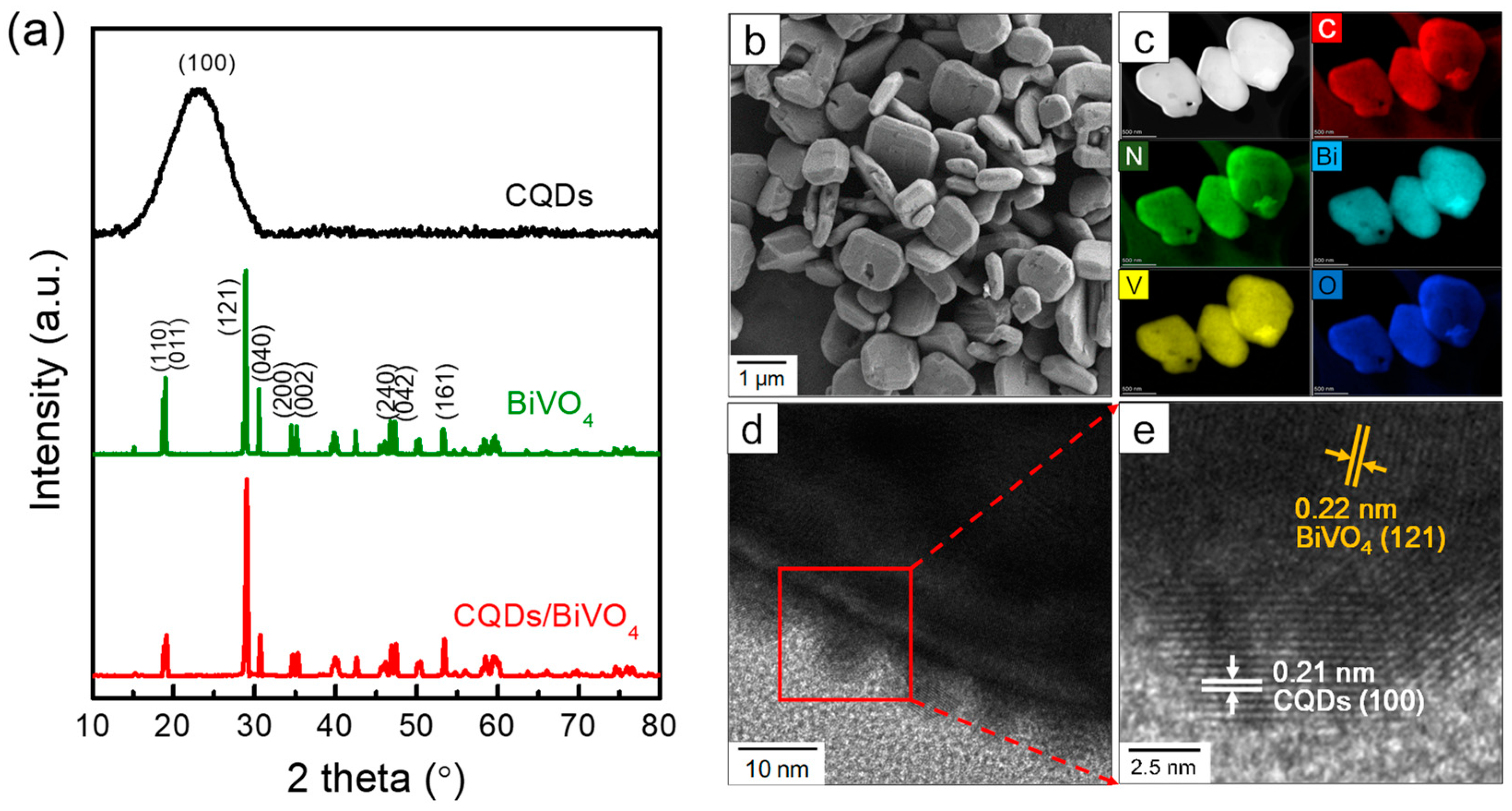
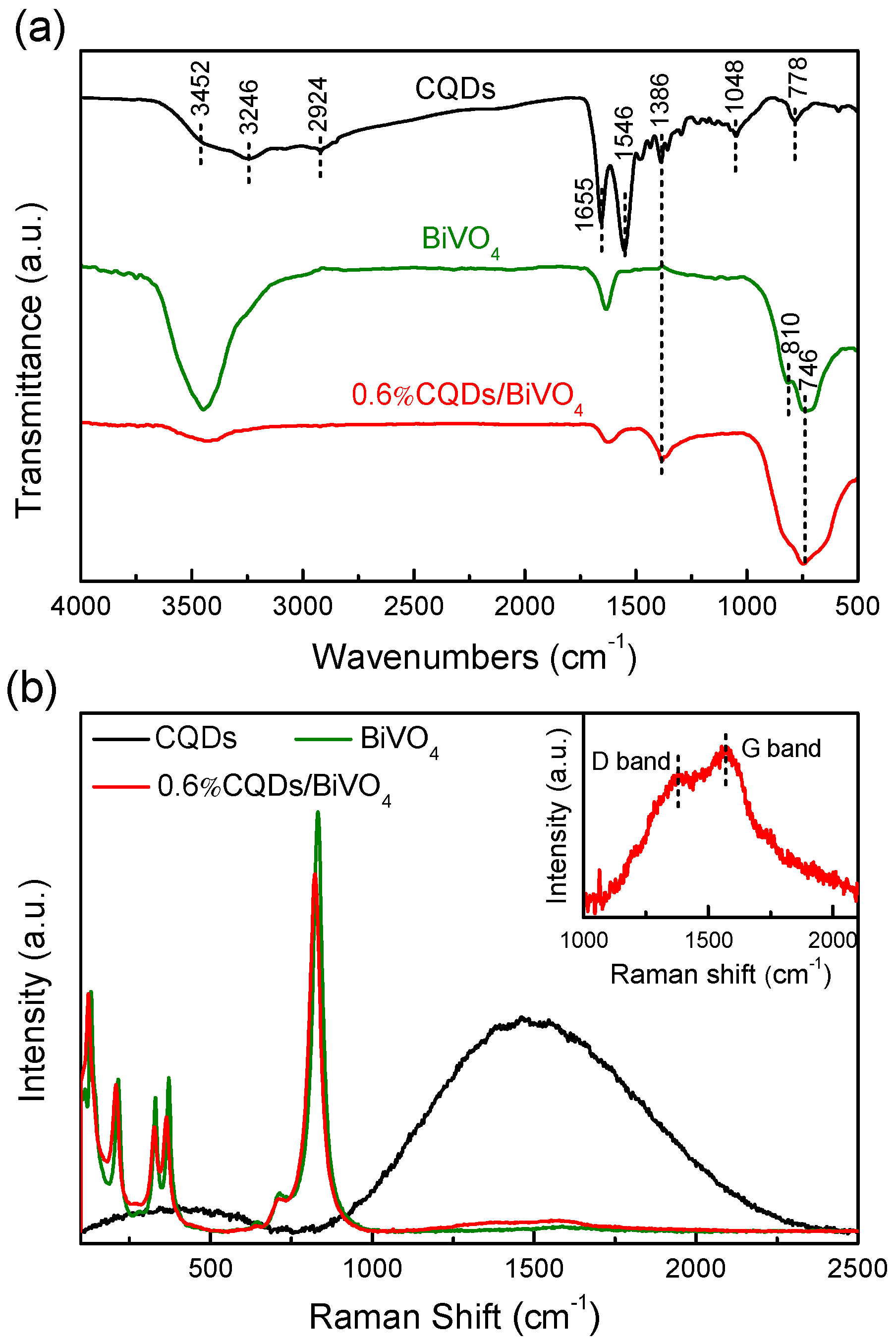
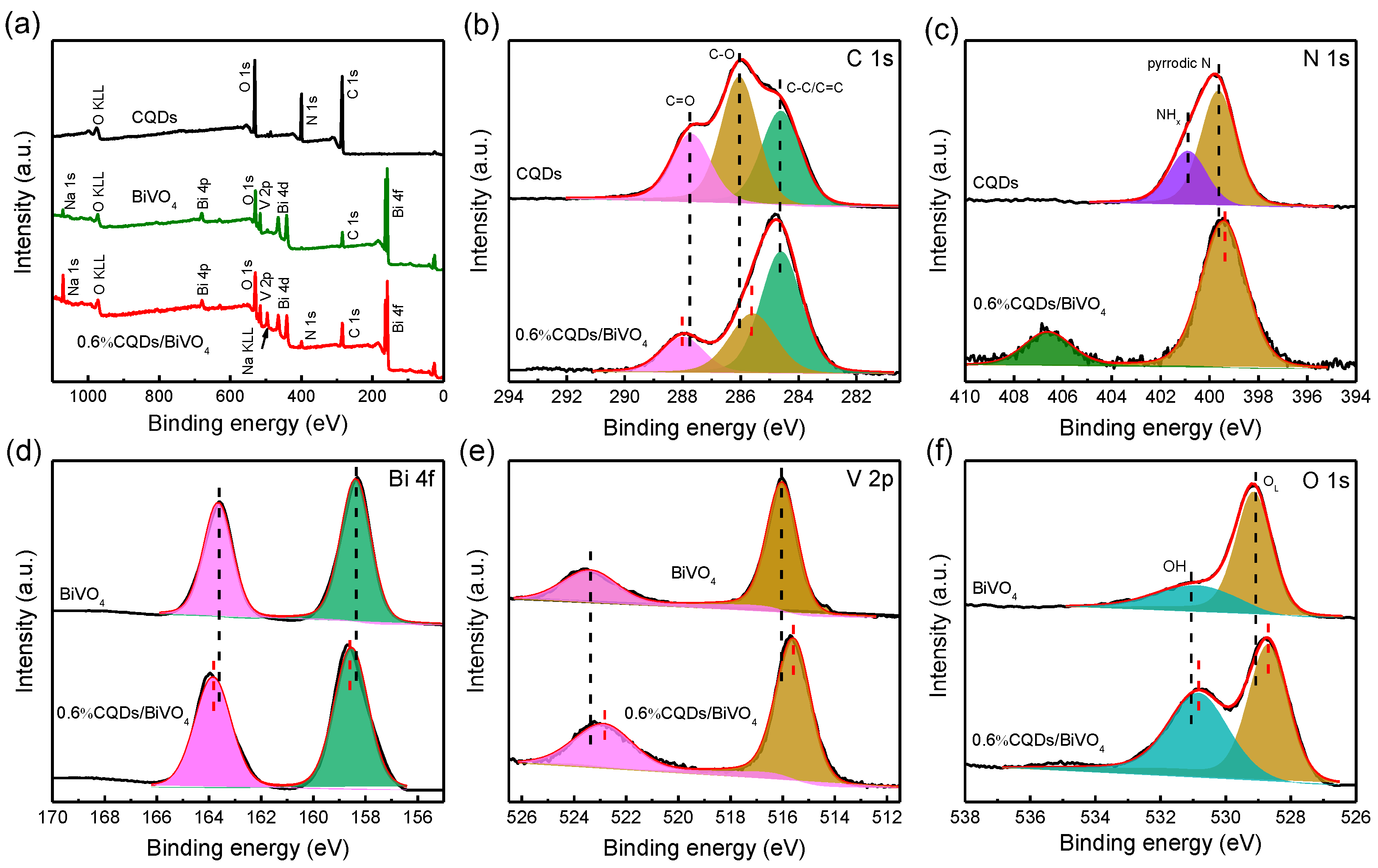
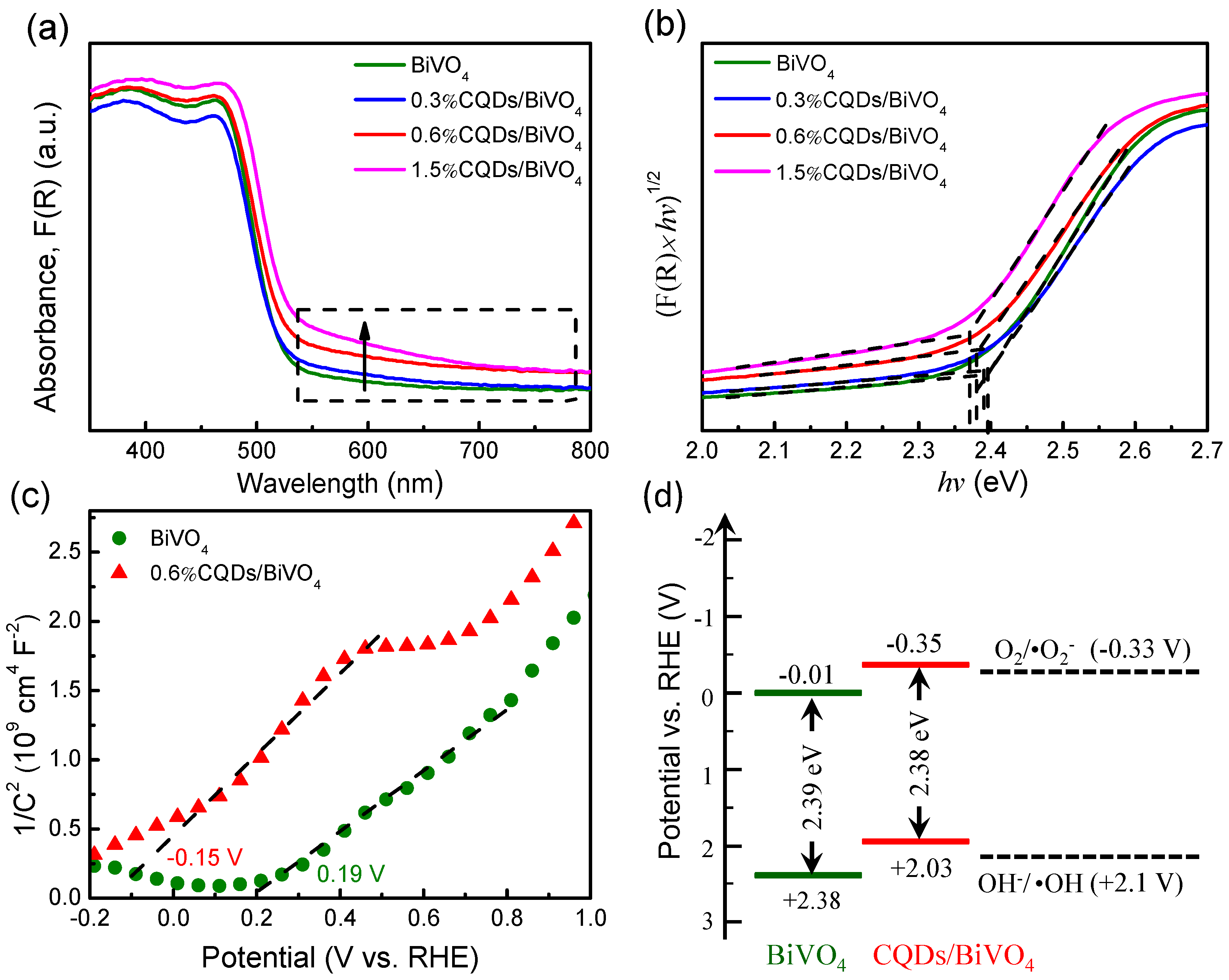
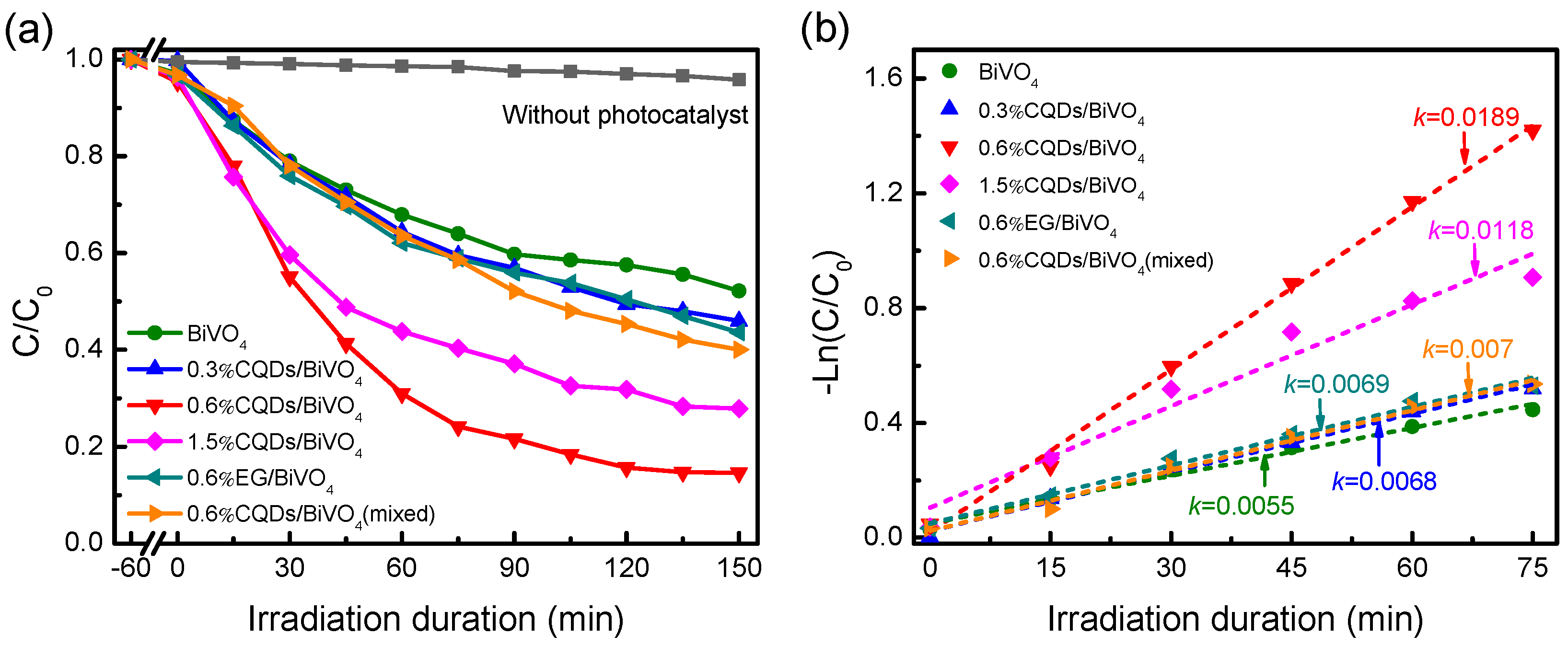
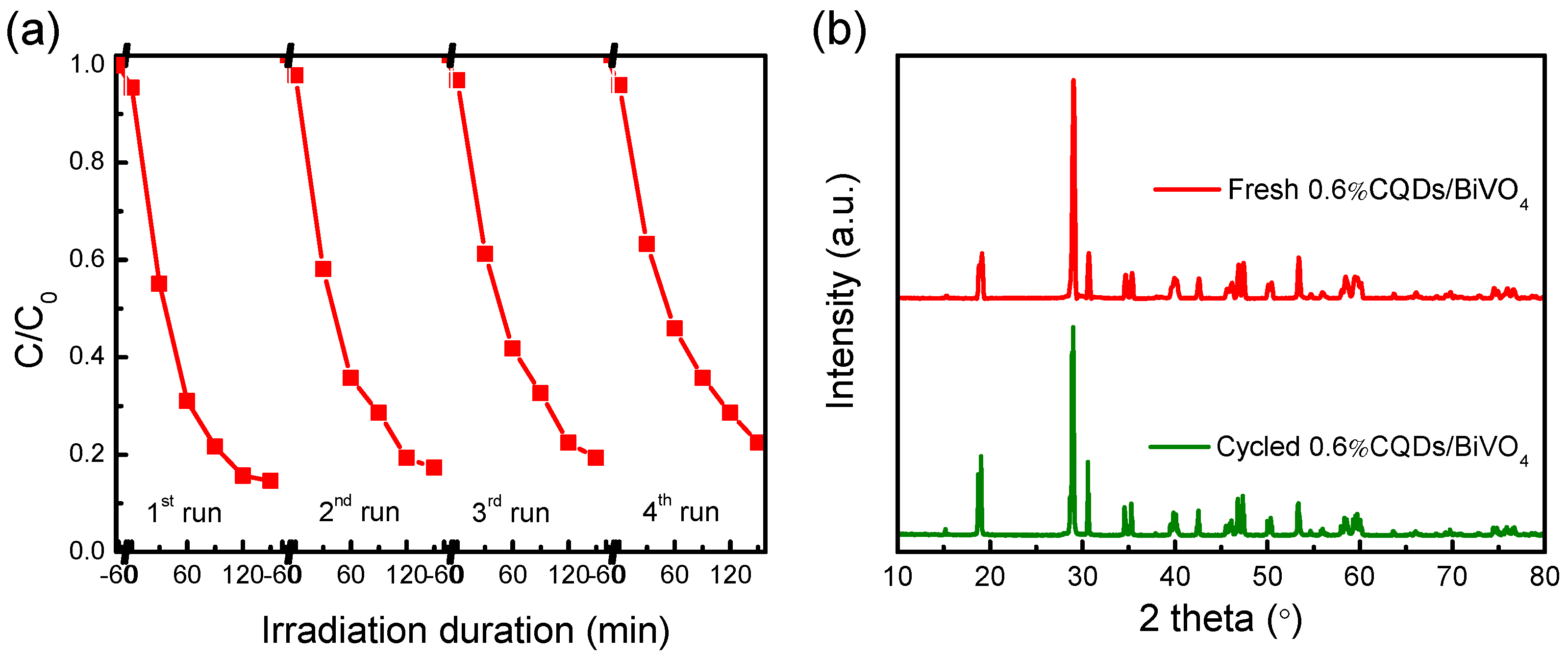


Disclaimer/Publisher’s Note: The statements, opinions and data contained in all publications are solely those of the individual author(s) and contributor(s) and not of MDPI and/or the editor(s). MDPI and/or the editor(s) disclaim responsibility for any injury to people or property resulting from any ideas, methods, instructions or products referred to in the content. |
© 2023 by the authors. Licensee MDPI, Basel, Switzerland. This article is an open access article distributed under the terms and conditions of the Creative Commons Attribution (CC BY) license (https://creativecommons.org/licenses/by/4.0/).
Share and Cite
Hu, C.; Chen, Q.; Tian, M.; Wang, W.; Yu, J.; Chen, L. Efficient Combination of Carbon Quantum Dots and BiVO4 for Significantly Enhanced Photocatalytic Activities. Catalysts 2023, 13, 463. https://doi.org/10.3390/catal13030463
Hu C, Chen Q, Tian M, Wang W, Yu J, Chen L. Efficient Combination of Carbon Quantum Dots and BiVO4 for Significantly Enhanced Photocatalytic Activities. Catalysts. 2023; 13(3):463. https://doi.org/10.3390/catal13030463
Chicago/Turabian StyleHu, Chenyan, Qingdi Chen, Maosheng Tian, Weiwen Wang, Junxia Yu, and Lianguo Chen. 2023. "Efficient Combination of Carbon Quantum Dots and BiVO4 for Significantly Enhanced Photocatalytic Activities" Catalysts 13, no. 3: 463. https://doi.org/10.3390/catal13030463
APA StyleHu, C., Chen, Q., Tian, M., Wang, W., Yu, J., & Chen, L. (2023). Efficient Combination of Carbon Quantum Dots and BiVO4 for Significantly Enhanced Photocatalytic Activities. Catalysts, 13(3), 463. https://doi.org/10.3390/catal13030463









